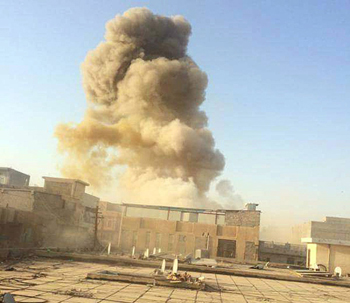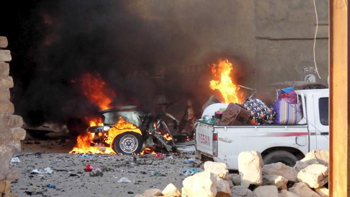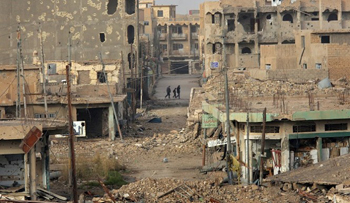Leading the suicide onslaught was a British Muslim
By Mark Ellis

Even though they were vastly outnumbered in the battle, ISIS used dozens of formidable new weapons known as “Vbieds” in their stunning defeat of Iraqi forces in Ramadi.
Vbieds are vehicle-borne improvised explosive devices. ISIS converted captured U.S. military armored vehicles designed to be impervious to small-arms fire into megabombs, according to a report in the Wall Street Journal.
Some of the Vbieds had explosive power equal to the force of the Oklahoma City bombing.
Over the three-day surge in Ramadi, ISIS fighters used at least 27 Vbieds, which destroyed Iraq security forces’ defensive perimeters and crumbled multistory buildings, according to The Journal.
Iraqi Prime Minister Haider al-Abadi said his forces were no match for the enemy’s weapons.

“They have the will to fight, but when they are faced with an onslaught by [Islamic State] from nowhere….With armored trucks packed with explosives, the effect of them is like a small nuclear bomb,” he told the British Broadcasting Corp.
ISIS used a clever, sophisticated battle plan to take Ramadi, which unfolded over several weeks. That plan outfoxed a much larger force of Iraqi troops as well as a U.S.-trained special-operations force known as the Golden Division, which fought for months to defend the city.
How the battle unfolded
At the end of April, officials in Anbar reported a flow of cars crossing from Syria into Iraq from a border crossing controlled by ISIS, according to The Journal.
ISIS fighters started arriving in Ramadi in groups of two or three in nondescript sedans, instead of the Toyota pickup trucks they used formerly, to blend in with civilian traffic and stay clear of U.S. surveillance planes.
In early May, ISIS enforced a blackout of its own media posts from Ramadi. “They displayed admirable operational security,” said Charlie Winter, a researcher who studies extremist groups. “They understand the element of surprise. And they understand how [the coalition] can track them,” he told The Journal.
On May 5, Islamic State initiated an attack on Ramadi’s city center, but Iraqi helicopters and the Golden Division rebuffed the advance. Battles erupted along the bridges across the Euphrates River that continued for several days, with Iraqi forces holding their lines.
By May 13, Islamic State placed a team of snipers closer to where Iraqi army units were based.
The next day, ISIS sent a single armored bulldozer to the concrete barriers on the perimeter of the government lines. The bulldozer worked without any opposition for almost an hour, removing concrete walls, according to officials.
Once the concrete barriers were removed, ISIS fighters drove six Vbieds into the heart of the government complex and blew them up. One of the six suicide bombers in the initial wave was a British Muslim, officials reported to The Journal.
“It was incredibly devastating, just horrific, gigantic explosions that took out entire city blocks,” a senior U.S.

official told The Journal.
Over the next 72 hours, the terrorist group set off at least another 20 Vbieds and suicide bombs, U.S. officials reported.
Islamic State took the government complex by May 15. The group launched another wave of vehicle suicide attacks on May 17, which prevented Iraqi reinforcements from entering the city.
The Golden Division, which had been cut off from the rest of the Iraqi forces, called for a retreat from town, Iraqi security officials told The Journal.
Once Islamic State’s black flag began flying from Ramadi’s city center, the group lifted its information blackout. It posted photos and eulogies for six suicide bombers it said were responsible for the initial wave of attacks.
They reported that the man identified as a British Muslim had once belonged to Syria’s al Qaeda affiliate before he joined ISIS. The other five were also foreign fighters from Arab nations.



